How A Prison Writing Group Helps Inmates Find Their Voice
Correctional Institution. But as writers, their voices
are reaching far beyond the prison walls.
by James Bigley II | Jan. 6, 2019 | 2:00 PM

PHOTOGRAPHED BY KEVIN KOPANSKI
Elijah* sits with the question, rolling the possibilities in his head.
“Are you a pen or a pencil?”
At 4-foot-10, he teeters on the edge of his chair before writing. He’s 37, African-American, a father of six and serving a 13-year prison sentence at the Lake Erie Correctional Institution for two counts of kidnapping and two counts of felonious assault.
Nine other men, wearing identical dark blue jump suits, sit in a circle with him. Ric, a 50-year-old musician with a knock-em-back bouncer’s build, sits to his right. He’s got two kids and a four-year lockup for kidnapping and felonious assault. But with hopes for early release, he may have only five more of these meetings remaining.
There’s Karl. He’s 61 and in a wheelchair. With pockets stuffed full of uncooked ramen packets, he’s serving five years on a fourth degree felony for operating a motor vehicle while impaired, his fifth such offense.
Some of the others around the circle are facing far worse sentences. But at the moment, they’re all wrestling with the same quandary: “Are you a pen or a pencil?”
The prompt comes from Kent State University professor Christopher Dum. Sporting green hair and a black polo, he doesn’t look like your traditional college professor — and perhaps that’s the point.
In the prison’s one-room library, it’s easy to forget electrified razor wire fences surround every inch of the facility.
A mural painted by a former inmate dominates the wall above black metal bookcases. Colorful superheroes Batman and Wonder Woman mingle with Darth Vader and other familiar characters, giving the allusion that we’re somehow transported to a 30-year-old middle school classroom.
Dum stares at his watch patiently, waiting for his students to finish. The ID13 Prison Literacy Project, as it’s known, works to get these men to think about themselves differently, to see themselves not as convicts but as writers with something meaningful to say to the world outside prison. For the past two years, the program has been publishing their works online and presenting their poetry at public readings.
When it’s time, Franklin is among the first to share. Bald with silver glasses, he’s spent most of the exercise thumbing through a new rhyming dictionary. Franklin had been requesting one for weeks, and Dum brought him a copy this morning.
“I’m more of a pen person. There’s less of a smearing effect. It only stands to reason, a pen I will select,” he says, sounding a bit like a Dr. Seuss character.
Everyone snaps their fingers.
Austin, who’s new to the class, goes next.
“My understanding is that a pencil stands for impermanence and erasure,” he says.
A baby-faced 27-year-old serving a life sentence for murder, he chooses to be a pen too. Erasing any part of his past, he contends, would alter the understanding of his present. “So, good or bad, I continue to add to the story,” Austin says, “because you can’t have a good story if you go back and erase the shitty parts.”
Everyone snaps their fingers.
“My whole life has been constructed like a pencil,” says Karl, a former chef. His white hair stands electric, exploding from his head in every direction like a modern Einstein.
“The point may be at once sharp and clean, but every time it gets worn down, it can re-create itself and be whatever it wants to,” he reads. “Its makeup is always constant, just like myself, but it can always sharpen itself to fit into whatever situation it needs to be in.”
The snapping of fingers.
“I felt immediately that I am the pencil, but due to that eraser, that cannot be true,” says Elijah, who writes every day from his bunk. He has nearly 30 pieces published on the ID13 website and sends his work to Dum every week.
“I try constantly to remove my imprint on the world, but the more I trust or the more I try, the more prominent it stands out,” he says. “I, like the pen, am filled with ink.”
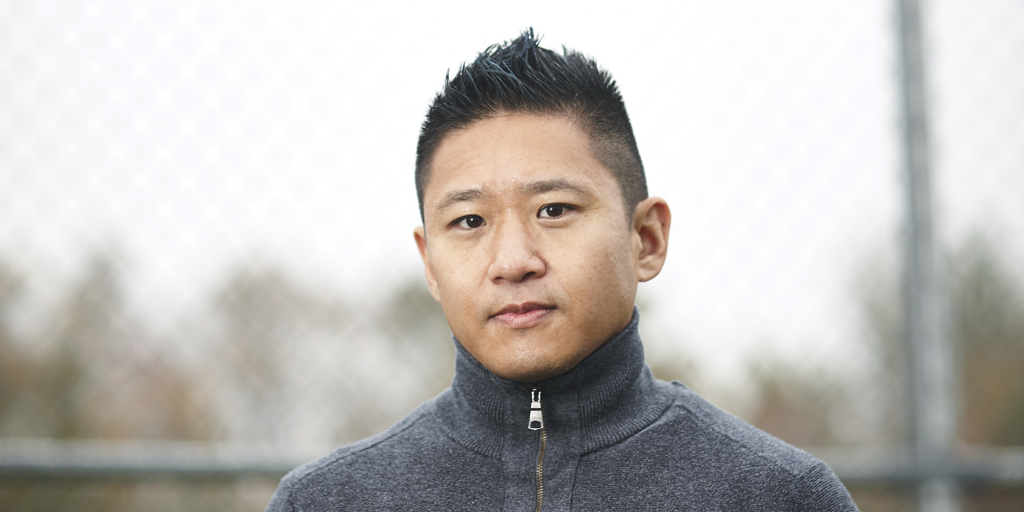
If the metaphor holds, Lake Erie Correctional Institution would likely be a pen.
The 52-acre minimum- and medium-security prison in Conneaut, Ohio, is not quite a Sharpie, but the effects of spending time here are not easily erased.
Staffed with about 300 employees, the institution is run as a modified open compound. Inmates can come and go from their dormitories to the prison yard during daylight hours except during chow and when being counted and accounted for by corrections officers. There’s a small baseball diamond for games in the summer and a swath of grass for flag football in the fall.
Red lines painted on concrete sidewalks between buildings indicate areas off-limits to inmates. The dormitories feel like Army barracks, with metal bunks stacked in rows.
“In here, everything is lines. You’ve got to wait to eat, wait to use the bathroom, wait to take a shower,” says Elijah, who’s been at Lake Erie for two years. “You can’t go to bed when you want to, and if you want to go to bed, they wake you up because they got to make sure you’re alive.”
Most of the time, things are relatively quiet, but sometimes they can get out of hand. Junk food purchased from the prison commissary is used as currency to barter with other inmates, and money owed is often the center of most fights. Disciplinary actions for breaking the rules can vary from revoking phone privileges and enacting bunk restrictions to being housed in segregation for up to 23 hours a day for more serious offenses.
“There are terrible things that go on — late night screams, beatings, stabbings,” says Elijah, who’s witnessed fights. “You do feel unsafe.”
As the first state-owned prison in the nation to be sold to a private institution, Lake Erie has had a spotty past. In 2011, the $73 million agreement with Corrections Corporation of America — now CoreCivic — was touted as a model for prison privatization. It was supposed to save state taxpayers money while elevating the welfare of its inmates. But a report from the state’s Correctional Institution Inspection Committee in February 2013 suggested failings in the prison’s infrastructure.
From 2010 to 2012, inmate-on-inmate assaults increased by more than 185 percent. Assaults on staff more than quadrupled during that same time. The rise in violence was a result of various circumstances, including a high turnover among staff, a lack of activities, with a large number of inmates on waitlists for academic programs, and an uptick in outsiders throwing bags of drugs, alcohol and cellphones over the perimeter fences for inmates on the inside.
“During that transition, there were some growing pains,” admits Brigham Sloan, Lake Erie’s warden, who was slated to leave the post Dec. 31. “I think there were some misunderstandings on what some expectations were.”
Two months after Lake Erie’s inspection reports were released, Sloan took over and began implementing changes. Some were basic structural improvements such as increasing the number of security cameras and installing electrified perimeter fences. Others increased the focus on rehabilitation and re-entry for the approximately 1,750 inmates.
By increasing inmate engagement and expanding programming to include groups like the ID13 Prison Literacy Project, Sloan hoped to boost the number of volunteers coming in and out of the prison who could make a positive impact.
“Good men can make bad choices,” says Sloan. “If you let the word ‘inmate’ define them, then they have no opportunities.”
On its last inspection in 2015, Lake Erie received high marks across the board, with assaults involving inmates decreasing by 56 percent. Sloan says that’s due in large part to a greater emphasis on the inmates’ re-entry.
“The gentlemen here usually can see the light at the end of the tunnel,” says Sloan. “Their release date is close enough that we need to be thinking about what’s going to happen when they’re released and how we can facilitate their restored citizenship.”
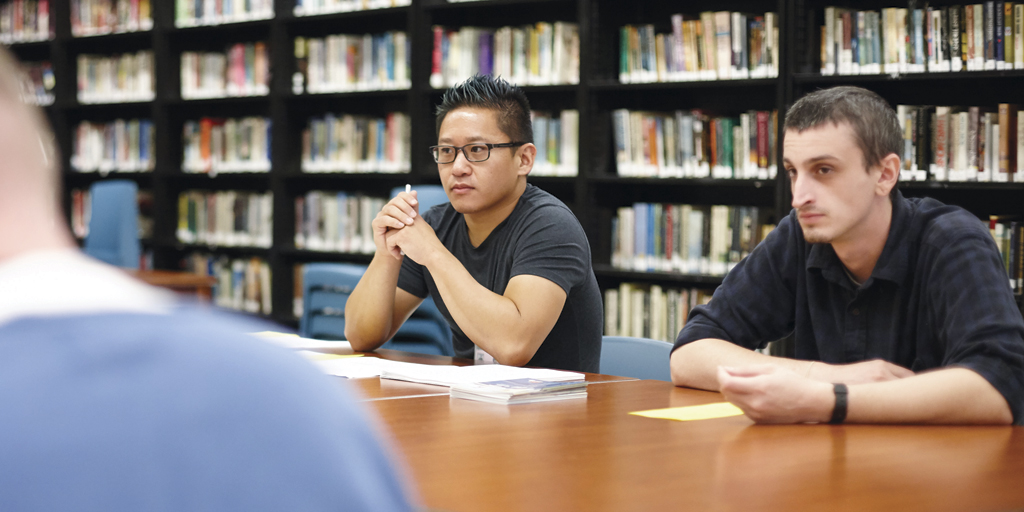
Elijah believes life is like a highway and prison is just a rest stop.
What happens at this rest stop matters. Travelers can stretch their legs and top off the gas before rushing back out headed in the same direction unchanged. Or they can take their time, reassess where they’re heading and go in a different direction. Maybe they can even stay a while, listen to the stories of others like them and learn something.
It’s a lesson Elijah picked up during a staff-led group called Go Further, where he was encouraged to analyze where his life of crime began.
“To be aware of where it started, it kind of helped to change [my perspective],” he says. Elijah pinpoints the start of his criminal life as a teenager growing up in Baltimore. “Most of my friends were drug dealers,” he says.
As the youngest in a large family, he was often overlooked. His father wanted him to learn from the Quran, but it was up to Elijah to study those lessons on his own. When he was in eighth grade, his grandmother died, and the family split up.
A band geek who sold weed, Elijah says he did what he had to do to survive. “The only way to fit in was to start doing the criminal stuff that everybody else was doing,” he says. “It never was really who I am, but it became me.”
So he’s been working toward improvement. Since his incarceration at Lake Erie in May 2016, Elijah has become certified in fiber optic and copper installation and serves as a mentor for the prison’s trauma program. He also oversees 96 other guys as commander of the prison’s veterans association.
On Fridays, he and others pore over the Quran in the chapel. In every group he’s joined, Elijah has learned to reconnect with the good things that were important to him on the outside.
ID13 takes a slightly different, more experimental approach. The literacy project asks participants to look inside themselves and project that to the outside world. In other words, they are not inmates taking a writing course, but writers who are in prison.
“We have the criminal justice system that has decided, in a sense, what people can or can’t do in society,” says Dum. “The guys in the prison have already gone through that apparatus. They’ve already been tried and sentenced.”
So, unless students bring up their records on their own, their crimes are rarely discussed. Instead, ID13 focuses entirely on the work produced.
Rather than Googling someone’s name and turning up a news story about the offense or a prison record, Dum says, maybe the results are different.
“In a sense, it’s trying to add a different narrative,” he says. “If you Google this person’s name, maybe you’ll find a poem or some artwork by them instead.”
In many ways, ID13 is trying to rewrite public perception about who can be rehabilitated and how that can be accomplished.
“I think that it’s important to show not everyone has forgotten them or views them as untouchable or not worthy of human connection,” says Dum.
For Elijah, ID13 has been empowering. “Here, only here, can we just be ourselves completely and totally and just unleash everything we have in our minds,” he says.
On the ID13 website, Elijah is prolific, publishing poems, drawings and reflections from a little more than a year in the group.
In “I Fix Things,” a 33-line poem, he turns his fiber optic and copper installation skills into the superhuman ability to break anything down. His narrator can repair and rebuild broken machinery to create new things — though in the end, he realizes the only thing he can’t fix is himself.
In “I Am,” a 100-word essay, Elijah wrestles with his issues in an attempt to reclaim power over them. “I am your reality blocker, your internal pessimist. I ensure whatever you decide goes wrong,” he writes. By the end, it’s clear how difficult the battle remains. “It’s not me, it’s you. I’m king. I am depression.”
“In my mind, everybody has some kind of burden that they’re trying to deal with,” Elijah explains. “I kind of want them to see that I’m just like them.”
In a short reflection titled “Changes,” he muses on why spring is his favorite season, tapping into questions of identity and exploring themes of nature and resilience.
“Just like the sprout I broke the soil grew to my predestined height bloomed my flower then withered away into this winter,” he writes. “But just like the perennial I will wait until I can spring loose and yet again strengthen my roots. What a funny thing change is.”
In his writing, Elijah can make the changes he dreams about. Born with spinal dysplasia, which stunted his growth, he fights against the perception that he’s weak because of his size. So, Elijah writes a new narrative.
“In my writings, I’m tall,” he says proudly. “I’m never in prison unless the writing prompt is that I’m in prison. I’m free, I’m in love, it’s bliss and everything is perfect.”
In order to publish outside the prison, ID13 must submit everything for approval by the Ohio Department of Rehabilitation & Correction’s Office of Victim Services to lessen the likelihood that victims or family members of those incarcerated are revictimized by the work that they publish.
Due to the nature of Elijah’s crimes, he writes under the initials E.L. “I believe E.L. is my childhood prior to my downfall,” he says. “I just want to get back to that, back to who I really was: the writer who enjoyed writing for writing’s sake.”

After the pen vs. pencil writing prompt, Dum’s assistant Bengt George passes out copies of a poem written by Youngstown-native Ross Gay. As with every piece of poetry introduced here, he has two students read it out loud twice while the rest follow along.
A Small Needful Fact
Is that Eric Garner worked
for some time for the Parks and Rec.
Horticultural Department, which means,
perhaps, that with his very large hands,
perhaps in all likelihood,
he put gently into the earth
some plants which, most likely,
some of them, in all likelihood,
continue to grow, continue
to do what such plants do, like house
and feed small and necessary creatures,
like being pleasant to touch and smell,
like converting sunlight
into food, like making it easier
for us to breathe.
At first, there’s confusion. Some in the group ask about Eric Garner’s story. Damerick, a tall, smooth-skinned 27-year-old who writes under the pen name J. Shrefi, offers up an explanation.
“He was selling cigarettes in the street,” he says, hands clasped in front of his chin. He puts his hands down and shakes his head while looking at the bright light from the ceiling overhead so that the tattoos of his children’s faces are revealed under his neck.
When Damerick joined the group in fall 2017, he wanted to write under a pseudonym that meshed his daughter’s initials with his son’s first name.
“All of my writing is for my little ones,” he explains to me in an email a month after the session. “I want to be a person that they are proud of. Proud to know, proud to be related to. I want them to know that they come from good and are not descendant of a man capable of the crimes the state of Ohio would have you to believe I committed.”
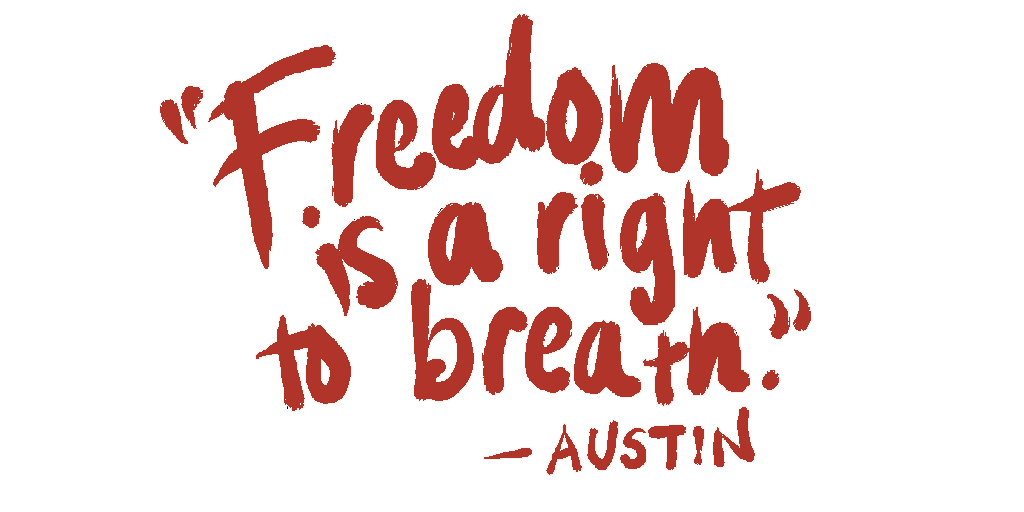
An Air Force veteran, he is serving a mandatory 10 years on two counts of burglary and one count each for rape and attempted rape. Although he maintains his innocence on those charges and his kids were not listed as victims, Damerick was denied his first choice of pen names by Victim Services. So he settled on a name that honors his brothers who both died and a mashup of fairy tale ogres Shrek and Fiona, who are ugly on the outside but beautiful on the inside.
“[Garner] was hounded by the police and they choked him out,” he says. “Put their knees on his back. Killed him in front of everybody.”
Not wanting to lose momentum, Dum asks everybody to write one small needful fact about themselves and the contribution they’ve made to the world.
At first, Austin, the baby-faced poet, seems perplexed. “This sucks,” he mutters. “I didn’t quite contribute to anything.”
And yet, he writes anyway. When time is up, he even volunteers to read his poem first.
“A needful fact?” he begins. “That all the same, we are born of stars, sun-forged atoms assembled to autonomy. Imperfect, however complex. None of these assemblies has any right or need to exorcise dominion or depth, to begin another’s decay.”
He takes a small breath.
“Such is our own choice,” he says. “Freedom is a right to breath.”An Air Force veteran, he is serving a mandatory 10 years on two counts of burglary and one count each for rape and attempted rape. Although he maintains his innocence on those charges and his kids were not listed as victims, Damerick was denied his first choice of pen names by Victim Services. So he settled on a name that honors his brothers who both died and a mashup of fairy tale ogres Shrek and Fiona, who are ugly on the outside but beautiful on the inside.
“[Garner] was hounded by the police and they choked him out,” he says. “Put their knees on his back. Killed him in front of everybody.”
Not wanting to lose momentum, Dum asks everybody to write one small needful fact about themselves and the contribution they’ve made to the world.
At first, Austin, the baby-faced poet, seems perplexed. “This sucks,” he mutters. “I didn’t quite contribute to anything.”
And yet, he writes anyway. When time is up, he even volunteers to read his poem first.
“A needful fact?” he begins. “That all the same, we are born of stars, sun-forged atoms assembled to autonomy. Imperfect, however complex. None of these assemblies has any right or need to exorcise dominion or depth, to begin another’s decay.”
He takes a small breath.
“Such is our own choice,” he says. “Freedom is a right to breath.”
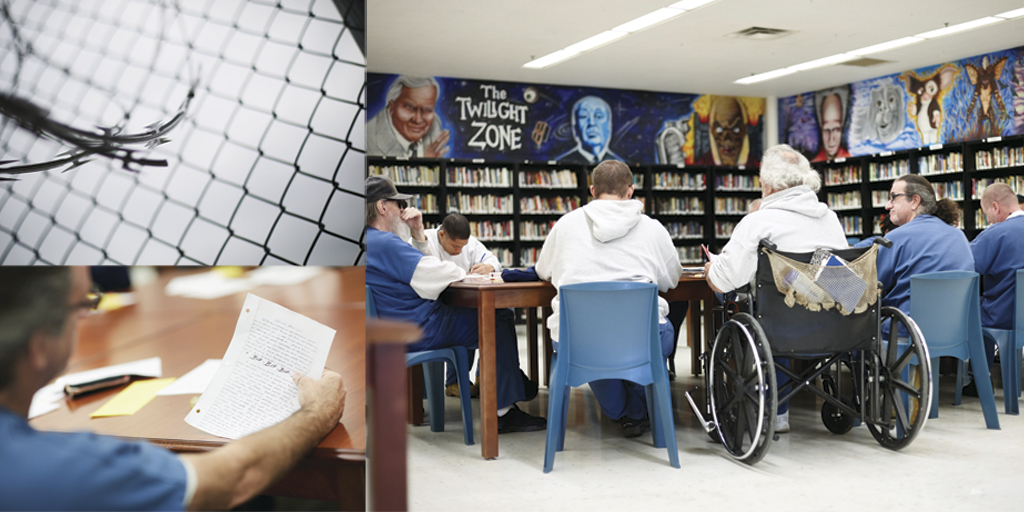
John Ledbetter seems lost.
When I find him in the Starbucks lobby downtown in early October, he’s staring inquisitively out the window at the giant Playhouse Square chandelier. He leans on a small black cane as we make our way upstairs to find a seat. At 48, he’s been diagnosed with neurosarcoidosis, an inflammatory disease that affects his spinal cord, which makes it hard for him to get around sometimes.
Ledbetter was released from the Lake Erie Correctional Institution two weeks earlier. He’s staying at the Salvation Army just around the corner, where he’s under supervision until March. The most important thing for the former web designer is to find a job and return to school. If he can do that, there’s a chance he’ll be permitted to live with his brother in Lakewood. But it’s more difficult than he had hoped.
In order to go anywhere, Ledbetter must create an itinerary for the day and get approval from his case manager. He has limited use of on-site computers to create a resume and apply for jobs online, but he isn’t allowed to have any social media accounts. To complicate things further, his disability is another barrier to employment.
“Had they simply opened the door and said, ‘Go ahead,’ it would have been easier for me,” he says. “But as it is now, I’m trying to qualify for a bracelet, or an anklet, for home monitoring.”
When he arrived at Lake Erie three years ago for drug trafficking and possession of criminal tools, he found very few opportunities for fulfillment outside of an education program with Ashland University.
“They basically want you laying on your rack, walking the yard or in the gym, and that’s it,” says Ledbetter, who earned 30 college credits in the Ashland program. “The thing that makes a human being a human being is their ability to make projects.”
So, he got a job as a prison library aide, helping to oversee more than 4,800 books and a law library with more than 300 items. One of his responsibilities was printing cardstock certificates for inmates graduating from other programs.
Ledbetter, in turn, used the excess paper to create greeting cards for other inmates and devised a way to sell them. In prison, inmates are not allowed to barter or buy items from each other, lest it encourage gang activity, but it gave Ledbetter a sense of purpose.
“The key [to rehabilitation] is to give positive project-building,” says Ledbetter. “The goal would be to show them a more meaningful way to employ their time or to give them a sense of self-worth.”
So when a group of inmates working in the library established a writing and reading club in summer 2016, Ledbetter was one of the first to join. More than an opportunity to discuss books and authors, it also created a space for the group members to be free-thinkers who could share their thoughts and emotions without fear of being judged.
As the inmate-led group grew to nearly 30 members, the librarian reached out to the graduate department at Kent State University to ask if they were willing to facilitate the class. Many of the members were working on chapbooks or short story collections and were inquiring how to publish their work.
Immediately, Halle Neiderman, then a doctoral candidate in rhetoric and composition, and Dum, who’d written a book about people trying to survive in residential motels, answered the call.
“They wanted their voices to be heard,” says Neiderman, who is currently on a three-year teaching assignment in Beirut. “We needed to make that happen and we needed to do it consistently.”
In the beginning, the weekly class was divided into monthlong segments with supplemental readings to go with inmate-selected books. When the group chose Koushun Takami’s Battle Royale — a novel in which junior high students are forced to fight to the death in a program run by an authoritarian government — Neiderman and Dum paired the book with Shirley Jackson’s “The Lottery,” in which a small town blindly follows a tradition that requires them to stone a person picked at random in order to maintain the town’s safety. Combined, these readings amplified a discussion around independent decision-making and free will.
Fight Club went with Herman Melville’s “Bartleby, The Scrivener” to spur discussions around identity, the fragile white male ego and the dangers of institutionalism. When they couldn’t request enough copies of sociology standard The New Jim Crow through the interlibrary loan system, Neiderman and Dum gave the class essays by George Yancey, Judith Butler and Langston Hughes.
“It gave people an opportunity to analyze a thing that they took as a complete presumption, that they just assumed was true, and they could analyze that and possibly see why it might not be true,” says Ledbetter.
Many of the inmates who barely had a high school education were suddenly hosting graduate-level discussions on race, segregation, love, loss and identity. At times, these discussions dovetailed into weeklong debates that challenged their beliefs.
“To me, that is a form of intellectual freedom,” says Ledbetter. “The fact that they’re incarcerated wouldn’t stop them from being able to exercise this personal growth and self-analysis.”
Yet early on, when the group members turned their work in for feedback, they signed their writing — not with their first or last names — but their state-issued inmate identification numbers. In fact, the name ID13 pays homage to the 13th Amendment, which abolished slavery except as punishment for a crime.
Within six months of the program’s official launch, Neiderman and Dum created a website to publish the inmates’ poems, short stories and essays online. In February, they even expanded to include public performances of the inmates’ work in local DIY settings and open mic nights.
“I think the writing reminds them that they’re humans,” says Neiderman. “If they can get that published, if they can have other people read it outside the institution, then other people will know they’re also humans and they’re not the horrible people that they’ve been treated like for however long they’ve been serving their sentence.”
Looking back, it was what Ledbetter needed to make the most of his last three years. In the days before he left Lake Erie, he corralled other members to keep it going and recruit men from throughout the prison to join.
“Human beings without projects are just animals,” he says. “I knew it needed to survive without me.”
Watch: Hear John Ledbetter read one of his poems from the ID13 Literacy Program Dec. 12 at Mac's Backs Books.

On the last day of August, I join Dum in the audience for a monthly reading series at Akron’s Nervous Dog Coffee Bar. He comes with three local poets acting on behalf of the inmates of ID13 to share their work.
Wearing a white T-shirt, silver-rimmed glasses and faded dad jeans, the first poet, a balding white man, reads a poem by J. Shrefi.
Anger
You make the wise man dense.
You surge through veins as a potent narcotic, crippling all logic and reason.
You are a drop of black dye in a clear glass of water, seeping steadily into loving hearts until chaos is all they can see.
It’s a love letter, of sorts, that peels back layers of emotion, so the writer can address the reader’s anxiety before he’s overcome.
Anger.
There’s an astigmatism to your vision,
Your sight is untrue.
When you look up remember,
That through that haze of red,
The sky is really blue.
When he’s finished, the audience claps. It’s enough to drown out the shrill sound of milk being steamed behind the coffee bar.
The second poet, a black man with a thick Haitian accent, steps to the mic to read a poem by Karl, the wild-haired white man who writes from his wheelchair.
I refuse to accept that nothing can be changed and all I can do about it is complain.
I refuse to sit idle and let the injustices done to good men go unchallenged.
I refuse to lower my standard or change my beliefs for the price of a couple donuts, and I refuse to accept that we cannot change and that this is my life.
A few people, not knowing Karl’s story, walk into the coffee shop to more applause.
The third poet, a white woman wearing a purple shirt and bedazzled jeans, has her brown hair wound tight. When she starts to read Elijah’s Beyond Fantasy, her voice is pure and strong, demanding of attention.
Can you see me in these words, in the sounds of the air as it ushers the oxygen combined with H2 in all solids and liquids?
Can you see me through the windows to my soul, the ocular cavities that presents its messages to the lightless void between my ears?
Her right hand clutches the paper while her left moves with the rhythm.
Do you have vision to see beyond the negative presumptions created by your own personal reflections and prejudgmental prejudice?
Do you see I am you and everyone else is me? Can you see our similarities?
Her voice rises above the grinding of coffee beans, the running of water.
Can you see that when the power of love overcomes the love of power that we can find peace?
A few whispers ripple through the crowd.
I was born Elijah before I became human, but can you see?
And in this moment something magical happens. While Elijah may be sitting on his bunk at the Lake Erie Correctional Institution, tucked away behind a razor wire, he is also here. He’s here in the form of a white woman pleading at a microphone in front of a sunlit window for an audience to listen.
In this moment, Elijah is free.
Elijah is you. Elijah is me.
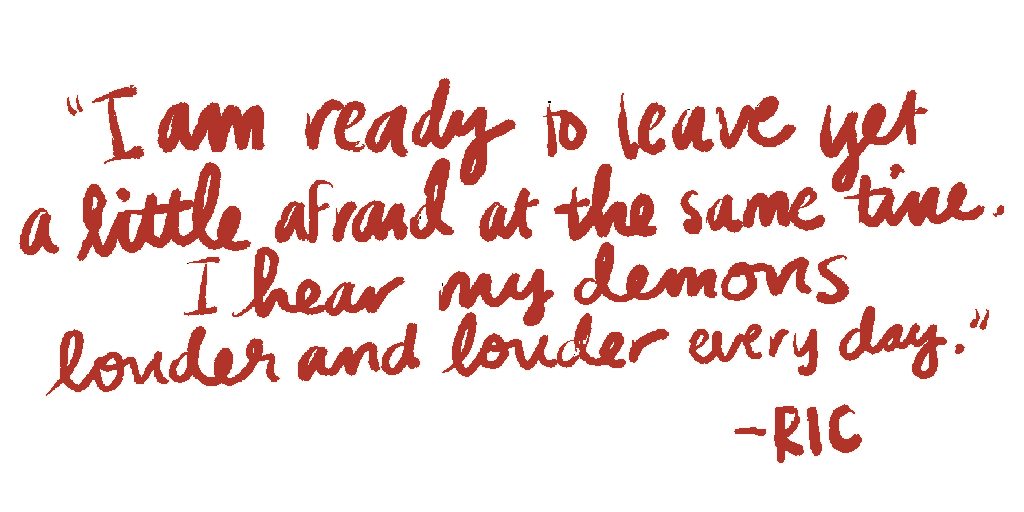
There’s still much to be written for ID13.
For his work with the inmates, Kent State University awarded Dum an $8,000 grant annually for three years to research how participation in this writing group affects the inmates and how the writing produced impacts the general public.
ID13’s facilitators began gathering data through a survey in which readers are given one of five random selections of writing: a negative news story about recidivism, a neutral research brief on the topic, a positive news story about a successful re-entry program or ID13 poems about the writers’ childhoods or their life in prison.
While the results are far from conclusive, the early returns are encouraging.
“We see that [poetry] significantly affects people’s willingness to get to know offenders, willingness to support re-entry initiatives and basically decrease the stigma and the social distance people want to create,” says Dum. “The only thing that moves the needle with people is poems.”
They’re also working to expand the program by giving Polaroid cameras to individuals to document their re-entry journey.
“Things don’t end when you leave prison,” says Dum. “I think it would be a horrible dereliction of moral duty not to continue those relationships on the outside in terms of involving them in everything the program gave to them on the inside.”
On Nov. 18, Ric sent me a message that his release date was postponed to early December. At the very least, the musician and father of two hoped to be out before Christmas.
“I am ready to leave yet a little afraid at the same time,” he wrote. “I hear my demons louder and louder every day. I am just not sure who I am after this experience, and to be honest with you — part of me wants to return to the madness and addiction in [an] attempt to finish the journey of self destruction I embarked upon so many years ago.”
His year and a half in prison has been marked by change and loss. He had his 50th birthday. His wife moved to Georgia with his dog and his kids. Three of his friends have died, including two to opioid overdoses.
“But at the same time, I’ve never been more excited to live and enjoy the moments life has to offer,” he continues. “I’m a walking contradiction.”
That even extends to his writing. When he joined ID13 last year, he wouldn’t participate. But over time, he became one of the group’s most frequent sharers. While none of his work in ID13 has been published, Ric has hopes of incorporating some of it into his music. He promised one of his friends that he’d make an album when he gets out.
For now, Ric has come to the opinion that everything he’s written in prison is shit. “That will not stop me from purging my feelings and emotions onto the page, but it has been a bit of an ego dent,” he writes.
So he ends his note with a poem, written from an ID13 prompt asking them to fill in the blanks: “I want to believe ______, but ______.”
I want to believe in true love
But my heart is far too scarred
I’d like to believe in JUSTICE
But clearly, it’s a fraud
I wanna think people are good
‘cept they all behave so bad
I pray that I’ll find happiness
In a world that is so, so SAD
I wish I could start a revolution
But they all end up LIES
Together we could change the world
If only we would try
I want to believe in America
But she seems so very F---ED
I’d like to hold her in my arms
But I’m just out of luck
Yet still…
I WANT TO BELIEVE.
Watch More: Wesley Dirmeyer is a former inmate from the Lake Erie Correctional Institution. But he's also a poet. On Dec. 12, for the first time since his release, he read his work publicly at Mac's Backs Books as part of the ID13 Prison Literacy Project. Listen to him read his poem "Homage."
For more updates about Cleveland, sign up for our Cleveland Magazine Daily newsletter, delivered to your inbox six times a week.
Cleveland Magazine is also available in print, publishing 12 times a year with immersive features, helpful guides and beautiful photography and design.
Trending
-
1
-
2
-
3
-
4
-
5










